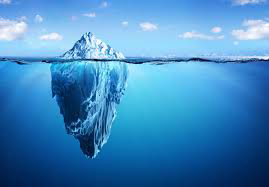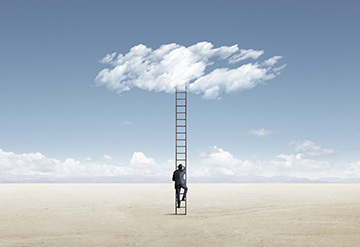The Mind
Dealing with the Subconscious and Inconscience
The Subconscious
The programme of personal growth gets the greatest resistance from the subconscious (the Freudian Unconscious) and the Inconscience and dealing with them is an important part of the programme. The inner or subliminal consciousness which extends to the Super-conscience at one end also projects to the subconscious at the other end to finally sink in the Inconscience. The subconscious is the repository of all movements that have been rejected from the conscious participation in the world, and these movements have the potentiality to rebound back to invade life; rebounds that may result in neurotic conflicts, recurrences of illness, chronicity of disease and lapses of character.
The Inconscience
The Inconscience, on the other hand, is the negation of everything, a negation of Truth, Joy, Knowledge and Life and thus the bedrock of falsehood, suffering, ignorance and death. Finally, the Inconscience of the individual lapses and merges into the terrestrial Inconscience so that it becomes the negation of existence as a whole.
The Load of the Subconscient
It requires great vigilance, attention and sincerity to work with the subconscient forces. One must have an experiential poise in the depths of one’s being or in the Superconscient heights so as to carry the Light without which probing the subconscient and Inconscient is risky. Moreover, each time one falls prey to one’s impulses, each time one indulges in vital lapses, each time one climbs down the scale of consciousness on the pretext of having some relaxation, “one increases the load of the subconscient — the huge subconscient load which one must clean and clean if one wants to mount, and which is like fetters on the feet.” And The Mother warns, “This is never told to children, they are allowed to commit all the stupidities in the world under the pretext that they need relaxation.
“It is not by sinking below oneself that one removes fatigue. One must climb the ladder and there one has true rest, because one has the inner peace, the light, the universal energy. And little by little one puts oneself in touch with the truth which is the very reason of one’s existence (1).”
It is not enough to be aware of the elements, forces and suppressed conflicts in the subconscient; what is necessary for the integral transformation is to change the subconscient to the conscient. One method is to be vigilant every moment so that anything that surges up from the subconscient to the superficial consciousness must at that very moment be caught hold of to be changed. The Mother describes, “There is a more direct method still: it is to enter the subconscient in one’s full consciousness and work there, but this is difficult. Yet so long as this is not done, all the progress one has made – I mean physically, in one’s body — can always be undone (2).”
The Zone of Defeatism
Both the subconscious and the Inconscience pose the greatest resistance to a growth in consciousness. The Mother described that they represent the zone of defeatism which must change as defeatism is anti-divine in nature, “Defeatism belongs to the subconscient –it MUST change, it must. Defeatism is anti-divine (3)”.
The only way for the aspirant of personal growth is to constantly evoke the Light and Truth of the Superconscient to clean the subconscious. The Mother describes:
‘”…. WE ARE — We are the Divine who has forgotten Himself. And our task, the task is to reestablish the connection — call it by any name you like, it doesn’t matter. It’s the Perfection we must become, that’s all.
“The Perfection, the Power, the Knowledge we must become, that’s all. Call it what you like, it doesn’t matter to me. That’s the aspiration we must have. We must get out of this mire, this stupidity, this unconsciousness, this disgusting defeatism that crushes us because we allow ourselves to be crushed.
“And we fear. We for its life (Mother touches the skin of her hands), for this thing. As if it were precious, because we want to stay conscious. But let’s unite with the Supreme Consciousness, and we’ll stay conscious forever! That’s IT, that’s exactly it.
I could put it this way: we unite our consciousness with what is perishable and we’re afraid to perish! Well, I say: let’s unite our consciousness with the eternal Consciousness and we will enjoy eternal consciousness (4).”
In fact, this zone of defeatism must be clarified so that the new race can come. The Mother clarifies:
“The subconscious is a mass of defeatism. That’s what keeps rising to the surface. As we ABSOLUTELY need to change that, the subconscient must be clarified so that the new race can come. We must clarify the subconscient. It’s a mire. It’s full of defeatism — defeatism, the first reaction is always defeatist. It’s absolutely disgusting…. We absolutely must… we must be categorical and vigorous — fearless, you know. Change it MUST (5). “
The Superconscience
However, the victory over this zone of defeatism is not easily secured. Even the plane of Global cognition or the Overmind plane, which is the plane where the godly qualities manifest, cannot fully overcome the resistance of the subconscious and the Inconscience. Sri Aurobindo explained that it is the transformative power of the highest Supramental plane (Integral cognition) that can fully and completely overcome the resistance of the subconscious and the Inconscience.
If the Superconscience is Reality, the Inconscience also is Reality; the Inconscience is in fact an inverse representation of the Superconscience. The Superconscience is present as a divine essence of everything that exists and thus the divinity of the human being is a primal reality. Hence, the ancient Indian declaration that the human being is a child of immortality stands justified. However, the evolution in nature that manifests life in its variegated multiplicity starts from the Inconscience which being a denial of everything is a repository of falsehood, ignorance and suffering and hence the Semitic assertion that the human being is born as un-divine (sinner) is a phenomenal reality. However, as the origin of the human being is in the Divine and as it is the Divine that is present as the inmost reality of everything in the soul-poise, it is the work of a consciousness-based paradigm to move from the status of the un-divine to be identified with the poise of the Divine which is one’s origin and which is secretly what one always is.
References
1. The Mother. The Collected Works of the Mother, Volume 4. 3rd ed. Pondicherry: Sri Aurobindo Ashram Trust; 2003, p. 156.
2. The Mother. Collected Works, Volume 7. 2nd ed.; 2003, p. 142.
3. (Ed.) Satprem. The Mother. Mother’s Agenda, Volume 13. Mysore: Mira Aditi Centre; 2013, [English transl.] 2013, p.226.
4. Ibid., p.227.
5. Ibid., p. 225.
Share with us (Comments, contributions, opinions)
When reproducing this feature, please credit NAMAH, and give the byline. Please send us cuttings.




